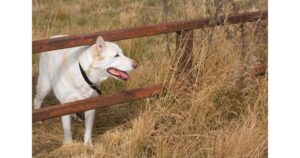If you’re looking for a way to keep your dog safe outdoors with the freedom to roam around and explore their surroundings. GPS Fence might be the answer you’re looking for! But do GPS dog fences Work is the area that needs to be explored further?
This innovative technology has developed over the years to help owners keep track of their beloved companions and to ensure their safety. It provides a sense of freedom to your dog while protecting them.
In this blog post, we’ll look at how Dog Fences work and discuss some of their advantages and disadvantages. I will share my advice on whether a GPS Fence is right for you and your furry friend. Read on to find out more!

A GPS Fence is a system that uses global positioning satellites (GPS) to keep track of your dog’s location. The technology uses an electronic containment system, which comprises a base unit and a receiver collar worn by the dog. When the dog collar comes into contact with the boundaries of the fence, it sent an alert to the base station warning you it has left its designated area. This allows you to take action and bring your pooch back home before they get lost or in any other trouble. If you lose track of your pup, you can use the GPS coordinates transmitted from their collar on a map to locate them.
Pros and Cons of GPS Dog Fences
Table of Contents
ToggleA GPS Fence is a device that uses global positioning system (GPS) technology to create an invisible boundary around your property. It works by emitting a signal from the primary unit that can pick up by the receiver collar worn by your dog. If your pup passes beyond the set boundaries, it will receive an audible warning sound and vibration via dog collar as a reminder to stay in its designated area. This prevents them from wandering off and keeps them safe within your property.
Pros of using a GPS Fence include convenience, cost-effectiveness, and peace of mind. These systems are simple to install and don’t need a lot of maintenance.
Some of the potential disadvantages include false alarms (if the collar’s signal is blocked by objects like trees or buildings). Possible confusion if your pet is not trained to understand the boundaries of their containment area. Some GPS Dog Fences can be expensive depending on features and the size of the area.
Different GPS Dog Fences
GPS Dog Fences come in a variety of styles and sizes to meet the needs of your pet. The most common type is the static fence, which emits an invisible boundary around the designated area that cannot cross without warning. This type offers convenience and can be set up with minimal effort.
Advanced models include wireless fences. It uses radio frequencies to emit a signal that can reach up to several hundred feet. It allows you to create many containment zones within one location and are ideal for larger properties or those who want more flexibility in setting boundaries.
Some GPS Dog Fences have extra features like tracking (i.e., real-time updates on your pet’s location) and remote access (i.e., the ability to adjust settings using a smartphone app).
The Benefits and Drawbacks Of Installing A GPS Dog Fence
Installing a GPS Dog Fence can be beneficial for pet owners who want to keep their dogs safe without having to check them. These systems offer peace of mind knowing that your pup is secure while still giving them the freedom to explore and roam around their environment.
The key benefit includes cost-effectiveness compared to physical fences. Then Comes easy installation, peace of mind that your pet won’t wander off or get lost/stray, and the ability to track your dog in real time.
Some drawbacks to be aware of as well. For example, GPS Fences may not work in all areas (especially those with poor reception), and they can also be costly depending on the features chosen. False alarms or excessive barking caused by the alarm can be an issue if your pet is not familiar.
Installation Tips for a GPS Dog Fence
Installing a GPS Dog Fence is straightforward, but there are still some tips to keep in mind to ensure it’s done properly. First off, make sure the chosen location has good reception, as this will affect how well the fence works. Be aware of any obstacles that could interfere with the signal such as trees or buildings.
When it comes time for installation, place the base unit and dog collar in a central location on your property. Follow instructions provided by the manufacturer, and note any safety precautions listed. Finally, be sure to train your dog so they understand how far they can go before receiving a warning sound.
Maintenance and Troubleshooting for a GPS Dog Fence
Maintaining and troubleshooting a GPS Dog Fence is crucial for ensuring it works and your pup stays safe. It’s important to check the system components (such as the base unit, collar, and boundary flags) for any damage or wear and tear. Keep the software up-to-date and replace the batteries as needed.
If you experience any technical issues, try resetting the system before contacting customer support. If all else fails, look at the user’s manual or online resources for troubleshooting advice specific to your model. If your pet is having difficulty understanding its boundaries, consider enrolling them in an obedience course to ensure they understand the importance of staying within the designated area.
With proper maintenance and troubleshooting, your GPS Dog Fence can provide years of reliable protection for your pet!
Alternatives to a GPS Dog Fence
GPS Dog Fences are not the only way to keep your pet safe while giving them the freedom to explore their environment. Other alternatives include physical fences, invisible fencing systems, and wireless dog doors.
Physical fences offer a reliable barrier that can be set up around your property’s perimeter. Invisible fencing systems emit a boundary area that can adjust remotely and is often more budget-friendly than GPS Fences. Finally, wireless dog doors allow your pet to enter and exit your home without requiring you to open the door –
Assess your needs before deciding which of these options will work best for you and your pup. It’s important to train your dog so they understand the boundaries set by the fence. End Of Content.
 Conclusion
Conclusion
Ultimately, there are many options available for keeping your pup safe in the outdoors. GPS Dog Fences provide a convenient and cost-effective way to do so, but other alternatives can be as effective depending on your needs. I hope your thought process will be much clear about Do GPS Dog Fences Work.
No matter which system you choose, proper installation and training are key for ensuring your pet’s safety. With the right setup and some training, your pet can enjoy their time outdoors without putting themselves at risk! End Of Content.
FAQs
What does the GPS dog fence cost?
The cost of a GPS Dog Fence can vary based on size and features but typically range from $600-$800. Basic models are the most affordable, while more advanced systems with extra features, such as remote access and tracking, may be pricier. Installation costs may also apply depending on your location and the type of system you choose.In addition to initial sales price, there may be extra costs associated with regular maintenance and troubleshooting as well. Ultimately, it is important to check your needs and budget before deciding which type of GPS Dog Fence will work best for you and your pet.
Can we train all dogs to invisible fences?
Invisible fences are a great way to keep your pet safe in the outdoors, but not all dogs can use them effectively. Dogs who are more intelligent and obedient do better with invisible fencing systems.
Ensure that the system is properly installed and maintained. Any underlying issues can prevent your pet from understanding the boundaries of the fence. Last, proper training with positive reinforcement is key to ensuring that your pet understands the expectations and boundaries set by the invisible fence.
Is GPS safe for dogs?
GPS is safe for dogs, though there are still some precautions to be aware of when using a GPS Dog Fence. It’s important to make sure that the dog collar fits properly and is not too tight around your pet’s neck. Check the battery regularly and replace it as needed. Finally, make sure the base unit is in a central location on your property and that any obstacles, such as trees or buildings, didn’t block the signal. With proper installation and maintenance, your pet can enjoy their time outdoors safely with the help of GPS technology.







